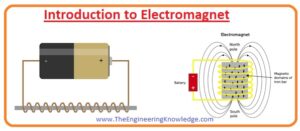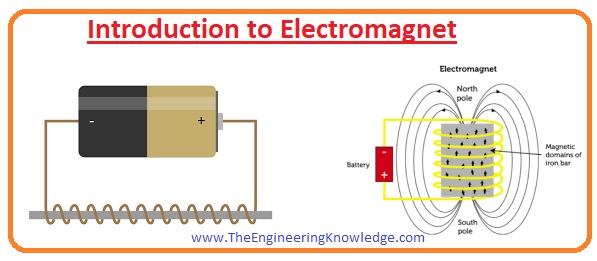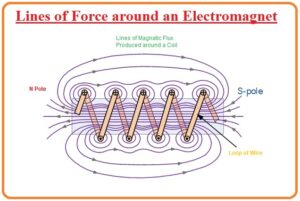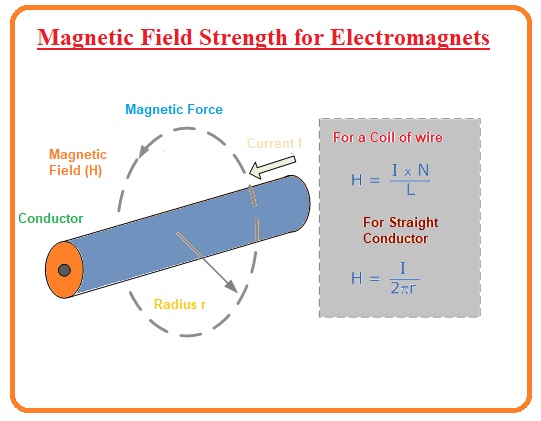 A modest electromagnet can be produced by wounding a wire round the soft iron wire. We have discussed in our last tutorial that current-carrying conductive material produce an amagnetic field round itself and the direction of magnetic field lines depends on the current direction which moving through the conductor we can also find it by left-hand rule.
A modest electromagnet can be produced by wounding a wire round the soft iron wire. We have discussed in our last tutorial that current-carrying conductive material produce an amagnetic field round itself and the direction of magnetic field lines depends on the current direction which moving through the conductor we can also find it by left-hand rule.
Electromagnets are fundamentally loops of cable which perform like bar magnets with a discrete north and South Pole when a current moves in the coil. The stationary field formed by every separate loop is added with its neighbor with the joint field concerted like the solitary cable ring. As we discussed it in the electromagnetism article. The resulting stationary magnetic field having north at one end and a south pole at the other is unvarying and sturdier in the midpoint of the loop than round the outside.
Introduction to Electromagnet
- THE electromagnet is a kind of magnet in which the field is created by a current.
- Electromagnets commonly contain cable coiled into a LOOP. A current moving in the cable generates a magnetic field which is concerted in a circle, indicating the midpoint of the loop. The field vanishes when the current does not exist.
- The chief benefit of an electromagnet above a permanent magnetic that we can easily vary magnetic field strength by changing the current flowing in the wire.
- But, dissimilar to an enduring magnet that wants no power supply, an electromagnet needs an incessant source of current to uphold the field.
- Electromagnets are extensively used as constituents of other electrical expedients, like motor, generator, electrical relays, etc.
Lines of Force around an Electromagnet
- A field that is generated is strained in a shape of a bar magnet providing a distinct north and south pole with the flux proportionate to the quantity of current moving in the loop.
- If extra covers of cable are coiled on a similar loop with a similar current curving, the power of the field will be augmented.
- It can be understood from this that the quantity of flux offered in any assumed magnetic circuitry is direct proportionate to the current passing through it and the number of turns of cable in the loop.
- This association is named Magneto Motive Force and is well-defined given below.
M.M.F= I x N (N is no of turns)
- The field strength is can be measured by this relation as no of turns will be higher there will be larger emf will produce.
The Magnetic Strength of the Electromagnet
- When the current is flowing in the two neighboring rods, magnetic fields are created regarding the current motion.
- .the fields of these two rods connect with each other in such a way that these two conductors bear a force.
- When the current is moving in a similar way the field amid the two rods is feeble producing a force of attraction.
- Similarly, when the current is moving in differing ways the field among them converts strengthened and the rods feel force of repulsion.
- The strength of this field around the rod is proportionate to space from it as moves away from the rod field becomes weaker.
- For one straight conductor, the current flowing and the distance from it are factors that govern the intensity of the field.
- The formula to measure the magnetic field strength is given below.
H =(l*N)/L
- In this equation:
- H is the magnetic field strength.
- N is no of turns of loop
- I is the current.
- L is length of the loop.
- From this equation, we can see the main factor on which magnetic field strength depends.
- The number of turns.
- The quantity of current moving in the coil.
- The sort of material.
- As we discuss earlier field strength depends on the type of material used the main function of materials is to concentrate flux in a specific path and avoid to loss it.
Electromagnet using a nail
- If the substance is non-magnetic for instance wood,it will allow very little current o flow it that way it hassles permeability.
- If though, the substance is prepared from a Ferromagnetic substance like iron a significant alteration in the flux density round the coil will be detected.
- Ferromagneticingredients are those which can be magnetized and are typically prepared from soft iron, steel or numerous nickel amalgams.
- The indication of this category of substances into a magnetic circuit has the consequence of focusing the magnetic flux creating it more intense and thick and intensifies the magnetic field formed by the current in the loop.
- We can demonstrate it by enfolding a loop of wire around a big soft-iron pin and linking it to a battery.
- This modest laboratory experimentation permits us to pick up an enormous amount of pins or jots and we can mark the electromagnet sturdier by adding more rounds to the loop.
Permeability of Electromagnets
- If dissimilar ingredients with similar physical magnitudes are cast-off in the electromagnet, the power of the magnet will differ in relative to the material used.
- This alteration in the magnetic strength is owed to the quantity of flux transient over the chief core.
- if the magnetic substantial has a higher penetrability then the flux lines can effortlessly be formed and permit through the chief core and permeability (μ) and it is a degree of comfort by which the core can be magnetized.
- The arithmetic constant for the permeability of a vacuum is μo= 4.π.10-7 H/m and the relative permeability of space is one.
- We use it reference to calculate all other materials’ permeability.
Relative Permeability,
- It is denoted by μris the multiple of μ and μo the permeability of free space.
Relative Permeability
Ur =u/uo
- This substance which has permeability less than vacuum are called diamagnetic like water, silver, etc.
- Those materials which has permeability larger than vacuum called paramagnetic such as gases.
Applications of Electromagnet
- It is used in motors and generators to create emf.
- It used in core of the transformer.
- It is used in different electrical relays
- It used in different bells and buzzers.
- It used in speakers and headphones.
- It used in different actuators like walves.
- It used in different recording instruments like the magnetic recorder, VCR, hard disks, etc.
- It used in magnetic resonating imaging machines.
- It uses in different scientific instruments like spectrometer.
- It used in accelerators.
- It used in different magnetically working locks.
- It uses in magnetic parting instruments which works for splitting magnetic from nonmagnetic substantial like splitting ferrous metallic from other substances in scrap.
- It usedin maglev trains.










